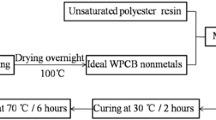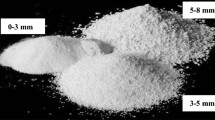Abstract
This study reported the effects of adding red ceramic waste in the production of composites with PU as a thermal insulator. The composites were characterized for chemical structure by FTIR, morphology by SEM and OM, thermal stability with TGA, and the mechanical properties, water absorption, and thermal conductivity were verified. For this purpose, composites were prepared to contain 10–30% red ceramic residue powder (brick) in the PU matrix and PU without residue. The composites presented similar thermal stability to the PU, and the FTIR bands of the urethane chemical bonds were verified. The microstructure analysis revealed the formation of a porous structure characteristic of the PU system. However, the increase in the residue concentration led to the formation of heterogeneous and open pores in the structure. This characteristic directly influenced the material properties, reducing compressive strength, Yong modulus, and thermal conductivity values and increasing the water absorption value. The thermal conductivity of all composites was lower than for PU, the best thermal insulation result obtained for the PUCER-10 composition. It is suggested that composite boards be prepared to be used as insulators with the incorporation of a certain amount of waste when seeking the environmental sustainability of the construction industry.
Graphical Abstract







Similar content being viewed by others
Availability of data and materials
The data sets generated during and/or analysed during the current study are available in the Repositório Universitário da Ânima (RUNA) repository, https://repositorio.animaeducacao.com.br/handle/ANIMA/4646.
References
Khan T, Acar V, Aydin MR, Hülagü B, Akbulut H, Seydibeyoğlu MÖ (2020) A review on recent advances in sandwich structures based on polyurethane foam cores. Polym Compos 41:2355–2400. https://doi.org/10.1002/pc.25543
Huo Y, Ge H, Lin C, Ying P, Huang M, Zhang P et al (2022) A thermally self-healing and recyclable polyurethane by incorporating halloysite nanotubes via in situ polymerization. Appl Compos Mater 29:729–743. https://doi.org/10.1007/s10443-021-09989-6
Puttegowda M, Rangappa SM, Jawaid M, Shivanna P, Basavegowda Y, Saba N (2018) Potential of natural/synthetic hybrid composites for aerospace applications. Sustainable Composites for Aerospace Applications, Elsevier; p 315–51. https://doi.org/10.1016/B978-0-08-102131-6.00021-9.
Marques DV, Barcelos RL, Parma GOC, Girotto E, Júnior AC, Pereira NC et al (2019) Recycled polyethylene terephthalate and aluminum anodizing sludge-based boards with flame resistance. Waste Manag 92:1–14. https://doi.org/10.1016/j.wasman.2019.05.013
Hipolito VL, Amorim VA, Gleize PJP, Girotto E, Júnior AC, Benavides R et al (2022) Techno-economic-environmental characteristics of polyurethane composite to thermal insulation for building with flame resistance: corroborative effect recycled of PVC and aluminum oxide. J Mater Cycles Waste Manag 24:452–465. https://doi.org/10.1007/s10163-021-01326-0
Oliveira P, Kilchert S, May M, Panzera T, Scarpa F, Hiermaier S (2022) Numerical and experimental investigations on sandwich panels made with eco-friendly components under low-velocity impact. J Sandwich Struct Mater 24:419–447. https://doi.org/10.1177/10996362211020428
Marques DV, Barcelos RL, Silva HRT, Egert P, Parma GOC, Girotto E et al (2018) Recycled polyethylene terephthalate-based boards for thermal-acoustic insulation. J Clean Prod 189:251–262. https://doi.org/10.1016/j.jclepro.2018.04.069
Ramesh M, Palanikumar K, Reddy KH (2013) Mechanical property evaluation of sisal-jute-glass fiber reinforced polyester composites. Compos B Eng 48:1–9. https://doi.org/10.1016/j.compositesb.2012.12.004
Chan KE, Yong LA, Ko YF, Mendez S (2017) Experimental and numerical studies of sustainable sandwich bio-composites derived from plant-based resources. J Sandwich Struct Mater 19:192–215. https://doi.org/10.1177/1099636215608785
Raman Bharath VR, Ramnath BV, Manoharan N. Kenaf fibre reinforced composites: a review. ARPN J Eng Appl Sci 2015;10.
Li Y, Mai Y-W, Ye L. Sisal fibre and its composites: a review of recent developments. Compos Sci Technol 2000:2037–55.
Adeniyi AG, Onifade DV, Ighalo JO, Adeoye AS (2019) A review of coir fiber reinforced polymer composites. Compos B Eng. https://doi.org/10.1016/j.compositesb.2019.107305
Tripathi P, Yadav K. Hybrid bamboo and glass fiber polymer composite-a review. vol. 4. 2017.
Bhatnagar R, Gupta G, Yadav S. A review on composition and properties of banana fibers. Int J Sci Eng Res 2015:49–52.
Gürgen S, Fernandes FAO, de Sousa RJA, Kuşhan MC (2021) Development of eco-friendly shock-absorbing cork composites enhanced by a non-newtonian fluid. Appl Compos Mater 28:165–179. https://doi.org/10.1007/s10443-020-09859-7
Keerthiveettil Ramakrishnan S, Vijayananth K, Pudhupalayam Muthukutti G, Spatenka P, Arivendan A, Ganesan SP (2022) The effect of various composite and operating parameters in wear properties of epoxy-based natural fiber composites. J Mater Cycles Waste Manag 24:667–679. https://doi.org/10.1007/s10163-022-01357-1
Ravikumar P, Rajeshkumar G, Manimegalai P, Sumesh KR, Sanjay MR, Siengchin S (2022) Delamination and surface roughness analysis of jute/polyester composites using response surface methodology: consequence of sodium bicarbonate treatment. J Ind Text 51:360S-377S. https://doi.org/10.1177/15280837221077040
Kavimani V, Gopal PM, Sumesh KR, Kumar NV (2022) Multi response optimization on machinability of sic waste fillers reinforced polymer matrix composite using Taguchi’s coupled grey relational analysis. SILICON 14:65–73. https://doi.org/10.1007/s12633-020-00782-x
Sumesh KR, Kanthavel K (2020) Synergy of fiber content, Al2O3 nanopowder, NaOH treatment and compression pressure on free vibration and damping behavior of natural hybrid-based epoxy composites. Polym Bull 77:1581–1604. https://doi.org/10.1007/s00289-019-02823-x
Abd El-baky MA, Hegazy DA, Hassan MA (2022) Advanced thin-walled composite structures for energy absorption applications. Appl Compos Mater 29:1195–1233. https://doi.org/10.1007/s10443-022-10016-5
Makgabutlane B, Maubane-Nkadimeng MS, Coville NJ, Mhlanga SD (2022) Plastic-fly ash waste composites reinforced with carbon nanotubes for sustainable building and construction applications: a review. Results Chem. https://doi.org/10.1016/j.rechem.2022.100405
Mak TMW, Chen PC, Wang L, Tsang DCW, Hsu SC, Poon CS (2019) A system dynamics approach to determine construction waste disposal charge in Hong Kong. J Clean Prod. https://doi.org/10.1016/j.jclepro.2019.118309
Tejaswini M, Pathak P, Ramkrishna S, Ganesh PS (2022) A comprehensive review on integrative approach for sustainable management of plastic waste and its associated externalities. Sci Total Environ 825:153973
Yuan Z, Nag R, Cummins E (2022) Human health concerns regarding microplastics in the aquatic environment—From marine to food systems. Sci Total Environ. https://doi.org/10.1016/j.scitotenv.2022.153730
Marques DV, Cremona Parma GO, Valezan IF, de Aguiar AC, Mendonça BAB, Cruz Junior A et al (2021) Cemental composites with polyurethane and recycled polyvinyl chloride: The influence of industrial waste addition on flammability. Polym Compos 42:3799–3811. https://doi.org/10.1002/pc.26094
Magnago RF, de Alcântara BT, de Aguiar AC, Baungarten P, Mendonça BAB, Silva HRT et al (2021) Recycling glass-polishing sludge and aluminum anodising sludge in polyurethane and cement composites: fire performance and mechanical properties. J Mater Cycles Waste Manag 23:1126–1140. https://doi.org/10.1007/s10163-021-01202-x
Dhaliwal GS, Anandan S, Chandrashekhara K, Lees J, Nam P (2018) Development and characterization of polyurethane foams with substitution of polyether polyol with soy-based polyol. Eur Polym J 107:105–117. https://doi.org/10.1016/j.eurpolymj.2018.08.001
Standard test method for apparent density of rigid cellular plastics. ASTM D1622/D1622M−14. ASTM 2020:1–4. https://doi.org/10.1520/D1622-14.
Standard test method for compressive properties of rigid cellular plastics. ASTM D1621−16. ASTM 2020:1–4. https://doi.org/10.1520/D1621-16.
Standard test method for water absorption of plastics. ASTM D 570–98 2000:1–3
Conley B, Cruickshank CA, Baldwin C (2018) Insulation materials. Comprehensive energy systems, vol. 2–5, Elsevier Inc.; p 760–95. https://doi.org/10.1016/B978-0-12-809597-3.00252-2.
Garrido M, Correia JR, Keller T (2016) Effect of service temperature on the shear creep response of rigid polyurethane foam used in composite sandwich floor panels. Constr Build Mater 118:235–244. https://doi.org/10.1016/j.conbuildmat.2016.05.074
Zhang XL, Duan HJ, Yan DX, Kang LQ, Zhang WQ, Tang JH et al (2015) A facile strategy to fabricate microencapsulated expandable graphite as a flame-retardant for rigid polyurethane foams. J Appl Polym Sci. https://doi.org/10.1002/app.42364
Brzeska J, Tercjak A, Sikorska W, Kowalczuk M, Rutkowska M (2020) Predicted studies of branched and cross-linked polyurethanes based on polyhydroxybutyrate with polycaprolactone triol in soft segments. Polymers (Basel). https://doi.org/10.3390/POLYM12051068
Vieira IRS, Costa L de F de O, Miranda G dos S, Nardecchia S, Monteiro MS de S de B, Ricci-Júnior E, et al. Waterborne Poly(urethane-urea)s nanocomposites reinforced with clay, reduced graphene oxide and respective hybrids: synthesis, stability and structural characterization. J Polym Environ 2020;28:74–90. https://doi.org/10.1007/s10924-019-01584-y.
Ramezani M, Monroe MBB (2022) Biostable segmented thermoplastic polyurethane shape memory polymers for smart biomedical applications. ACS Appl Polym Mater 4:1956–1965. https://doi.org/10.1021/acsapm.1c01808
Zhou X, Fang C, He X, Wang Y, Yang J, Yang L et al (2017) The morphology and structure of natural clays from Yangtze River and their interactions with polyurethane elastomer. Compos Part A Appl Sci Manuf 96:46–56. https://doi.org/10.1016/j.compositesa.2017.02.009
Budhathoki P, Paudyal G, Oli R, Duwal N, Bhattarai J (2018) Assessment on the characterization of mineralogical phase of ceramic tiles available in kathmandu valley (Nepal) using XRD and FTIR analyses. Int J Appl Sci Biotechnol 6:238–243. https://doi.org/10.3126/ijasbt.v6i3.21171
Díaz-Gomez A, Godoy M, Berrio ME, Ramirez J, Jaramillo AF, Medina C et al (2022) Evaluation of the mechanical and fire resistance properties of rigid tannin polyurethane foams with copper oxide nanoparticles. Fibers Polymers 23:1797–1806. https://doi.org/10.1007/s12221-022-4152-x
Thirumal M, Singha NK, Khastgir D, Manjunath BS, Naik YP (2010) Halogen-free flame-retardant rigid polyurethane foams: effect of alumina trihydrate and triphenylphosphate on the properties of polyurethane foams. J Appl Polym Sci 116:2260–2268. https://doi.org/10.1002/app.31626
Yang R, Hu W, Xu L, Song Y, Li J (2015) Synthesis, mechanical properties and fire behaviors of rigid polyurethane foam with a reactive flame retardant containing phosphazene and phosphate. Polym Degrad Stab 122:102–109. https://doi.org/10.1016/j.polymdegradstab.2015.10.007
Sung G, Kim JH (2017) Influence of filler surface characteristics on morphological, physical, acoustic properties of polyurethane composite foams filled with inorganic fillers. Compos Sci Technol 146:147–154. https://doi.org/10.1016/j.compscitech.2017.04.029
Kim JH, Ahn JH, Kim JD, Lee DH, Kim SK, Lee JM (2021) Influence of silica-aerogel on mechanical characteristics of polyurethane-based composites: thermal conductivity and strength. Materials. https://doi.org/10.3390/ma14071790
Zanini NC, de Souza AG, Barbosa RFS, Rosa DS, Mulinari DR (2021) A novel hybrid polyurethane composites with ZnO particles and sheath palm residues: synergistic effect. Polym Compos 42:532–542. https://doi.org/10.1002/pc.25845
Heaney DF (2012) Powders for metal injection molding (MIM). Handbook of Metal Injection Molding, Elsevier Inc.; p 50–63. https://doi.org/10.1533/9780857096234.1.50.
Członka S, Strąkowska A, Kairytė A (2020) Effect of walnut shells and silanized walnut shells on the mechanical and thermal properties of rigid polyurethane foams. Polym Test. https://doi.org/10.1016/j.polymertesting.2020.106534
Zhang G, Wang B, Ma L, Wu L, Pan S, Yang J (2014) Energy absorption and low velocity impact response of polyurethane foam filled pyramidal lattice core sandwich panels. Compos Struct 108:304–310. https://doi.org/10.1016/j.compstruct.2013.09.040
Trovati G, Natali Suman MV, Sanches EA, Campelo PH, Neto RB, Neto SC et al (2019) Production and characterization of polyurethane castor oil (Ricinus communis) foam for nautical fender. Polym Test 73:87–93. https://doi.org/10.1016/j.polymertesting.2018.11.010
Wi S, Park JH, Kim YU, Yang S, Kim S (2021) Thermal, hygric, and environmental performance evaluation of thermal insulation materials for their sustainable utilization in buildings. Environ Pollut. https://doi.org/10.1016/j.envpol.2020.116033
Acknowledgements
This study was supported by Instituto Anima/Universidade do Sul de Santa Catarina and CNPq/PIBITI. This work was a partial financial supported by the Foundation of Amparo to the Research and Innovation of the State of Santa Catarina [No. 06/2017, Research Group on Active Materials].
Funding
The activities presented in this work received a partial financial support by the Foundation of Amparo to the Research and Innovation of the State of Santa Catarina [No. 06/2017, Research Group on Active Materials].
Author information
Authors and Affiliations
Corresponding author
Ethics declarations
Conflict of interest
The authors declare no conflict of interests.
Additional information
Publisher's Note
Springer Nature remains neutral with regard to jurisdictional claims in published maps and institutional affiliations.
Rights and permissions
Springer Nature or its licensor (e.g. a society or other partner) holds exclusive rights to this article under a publishing agreement with the author(s) or other rightsholder(s); author self-archiving of the accepted manuscript version of this article is solely governed by the terms of such publishing agreement and applicable law.
About this article
Cite this article
Magnago, R.F., Baungarten, P., Mendonça, B.A.B. et al. Recycled brick red-based boards for thermal insulation: filler to polyurethane composite. J Mater Cycles Waste Manag 26, 239–251 (2024). https://doi.org/10.1007/s10163-023-01821-6
Received:
Accepted:
Published:
Issue Date:
DOI: https://doi.org/10.1007/s10163-023-01821-6




